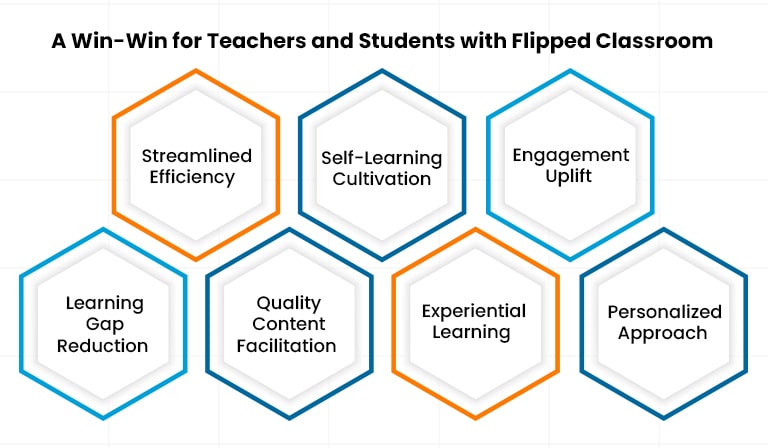Reaping the 7 Benefits of Flipped Learning – Part 2
In the dynamic realm of education, innovation continues to redefine how we empower learners to flourish. Among these transformative approaches, the spotlight turns to the captivating concept of Flipped Learning.
Imagine students eagerly delving into new concepts at their own pace, arriving in classrooms ready to dive into discussions and applications. Get ready to journey through the benefits of flipped learning, where the roles of teacher and student intertwine to create an enriched educational experience that resonates far beyond the four walls of the classroom.
For an overview of Flipped Learning, check out “The Art of Flipped Learning Unveiled: Part 1”
In theory, flipped learning may sound promising, yet this raises the crucial question about its practical effectiveness in the real world. Let’s explore further.
Does a Flipped Classroom Increase Student Engagement?
In the realm of education, when we compare traditional lectures with flipped classes, we open a door to a world of fresh opportunities. Here, students get to dive deeper into activities that directly connect with what they’re learning. And when we turn to the numbers, the evidence leans noticeably towards the effectiveness of this exciting approach.
Over 70% of students held the belief that flipped classrooms had the potential to assist them in mastering crucial and intricate areas of knowledge, nurturing their enthusiasm for learning, improving their active involvement in the classroom, and fostering their sense of independent learning.
Now without further ado, let’s dive into the perks of a Flipped Classroom.
What are the 7 Benefits of Flipped Learning?

- Efficient Reduction of Initial Topic Introduction for Educators
In traditional classrooms, a lot of time is spent just delivering information. That leaves little room for deep dives into knowledge. But in a flipped classroom, students get the basics on their own before in-person classroom sessions, which means educators can spend less time on basics and more on exploring topics deeply.
- Cultivation of Self-Directed Learning Proficiency Among Students
Being able to learn on your own is highly beneficial, especially for higher education. With a flipped classroom approach, learners get the initial information and course content at home, usually through videos, pdfs, or interactive content on a digital learning platform like Möbius– Learners get used to learning at their own pace, but with enough supervision to guide them whenever needed through digital assessments and immediate feedback.
- Enhanced Potential for Crafting Engaging Instructional Sessions
Enhancing student engagement is crucial in education, as it significantly bolsters the retention of concepts among learners. In a flipped classroom, since students know the basics already, there’s more time for fun and excitement in class. This means interactive learning, cool experiments, in-depth group discussions, presentations, debates, and real-world practice get a bigger spotlight.
- Mitigation of Learning Disparities Arising from Student Absenteeism
School absenteeism is a common occurrence with significant repercussions. Across the globe, millions of students miss important lessons, leading to detrimental effects on their learning progress. While a flipped classroom approach cannot completely resolve this issue, it does offer assistance. By providing essential information online, students who were absent can work to bridge the learning gap at their own convenience.
- Facilitation of Reusable, Personalized Pedagogical Content Creation
Within the framework of a flipped classroom, educators can foster connections with fellow teachers. This platform enables the exchange of valuable insights, course materials, and instructional resources. Many educators choose to create their own content, infusing it with a distinct personal touch that resonates powerfully with learners. Furthermore, this personalized content can be repurposed and used again.
- Fostering In-Depth Comprehension and Active Learning Amongst Students
Within a flipped classroom paradigm, students are enabled to construct a profound comprehension of subjects through experiential learning, diverging from traditional monotonous lectures. Here, students actively construct their own cognitive frameworks under the guidance of educators. For example, students can act as educators and explain complex concepts to the class, these active engagement techniques translate to enhanced learning outcomes.
- Enablement of Tailored Pedagogical Approaches for Educators
A flipped classroom model empowers educators with the flexibility to allocate their time precisely where it is most required. This capacity enables a targeted concentration on individual student requirements, as classroom sessions are dedicated to fostering comprehensive understanding. Consequently, instructors are adept at identifying and bridging knowledge gaps among learners.
The flipped classroom isn’t just a change in teaching – it’s a game-changer for everyone.
The Möbius Platform: Empowering Effortless Flipped Learning
The Interactive Möbius platform, by DigitalEd India, enables educators and institutions to seamlessly implement flipped lessons, elevating the educational experience for all.
Foster a seamless Flipped Learning ecosystem with Möbius:
- Craft, develop, launch, and share interactive digital course content
- Access a rich repository of randomized algorithmic questions
- Enrich STEM understanding through multimedia visualization
- Customize digital course content to suit individual student needs
- Guage student knowledge with embedded questions in flipped lessons
Ready to explore the Möbius experience?
Schedule an immersive product demo session now!
Stay tuned for Part 3 of the Flipped Learning series, where we will discuss the seamless ways to implement and integrate flipped lessons into your existing methods.
(Statistics source: Department of Education)